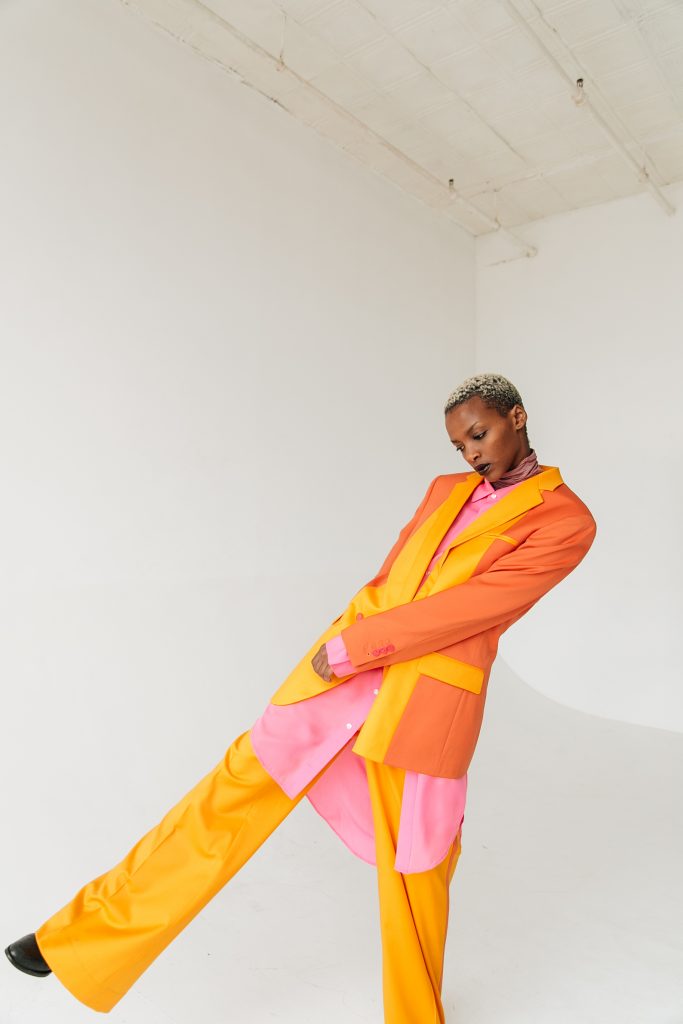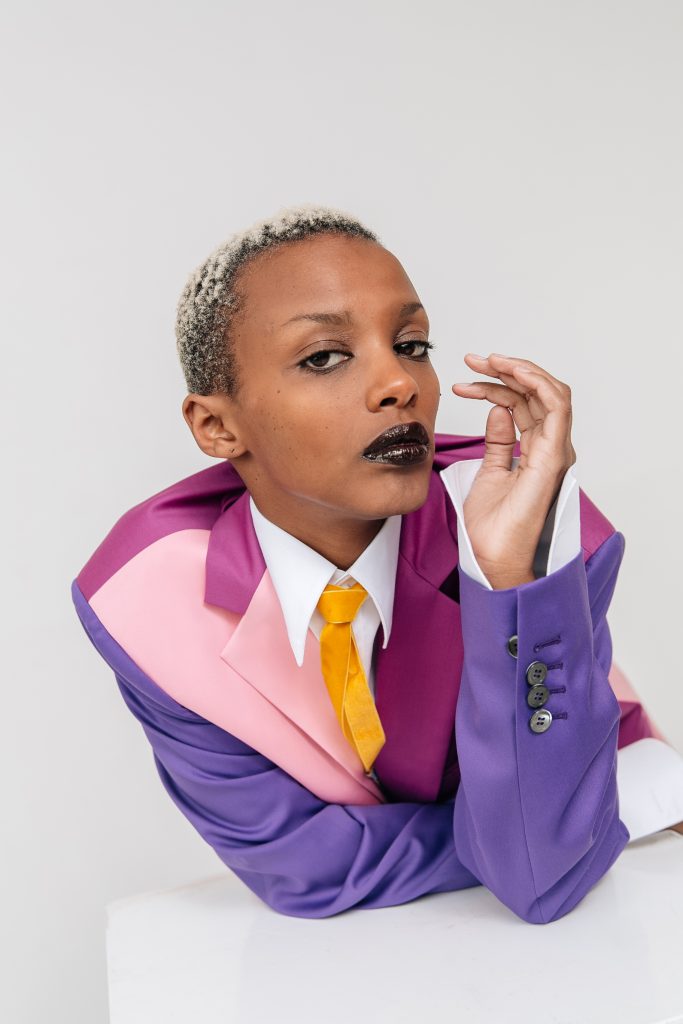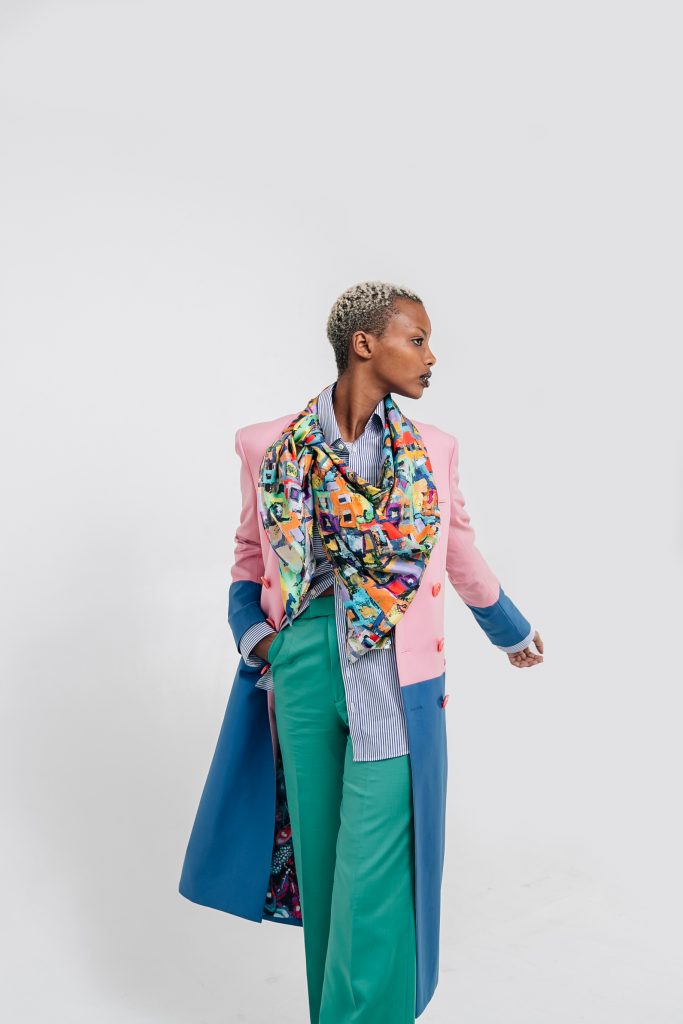Yseult’s Aposematic Fashions
BESPOKE IDENTITY examines the significance of suiting and personal style at the intersection of gender identity and presentation. The goal? To challenge the misconception that Queer identity is a monolith by celebrating the profusion of LGBTQ+ self-expression and identification.
This profile is dedicated to Yseult Polfliet. Model, fashionista, activist, and co-founder of the genderless children’s clothing brand Yoah, Yseult is a renaissance woman for the age of intersectional feminism and queer liberation. Refreshingly candid and remarkably self-motivated, Yseult talked to me about how modesty influences her style choices, her reservations about repurposed heteronormativity in the queer community, and her thoughts on the lack of meaningful inclusivity in the fashion industry. Meet Yseult:

On her queer identification and her qualms pertaining to the queer community’s adoption of quasi-essentialist labeling:
YSEULT: I’m part of the queer community and identify as a lesbian, and I find it really interesting how the definition of queer is limited, even in LGBTQ+ spaces. It almost feels like there’s a script: if you’re a lesbian, what type of lesbian? And how does your gender presentation correlate? I’m gay, but I like to switch it up: sometimes I’ll be dressed in oversized clothes, but I like wearing summer dresses and sexy see-through pieces. My sexuality doesn’t determine how I dress. I’ve seen people on social media be attacked for not being “butch” or “femme” enough. It’s stupid. Some people have even questioned the fact that I’m gay. I had a conversation with a friend where she told me she thought I was the woman or bottom in the relationship. I’m a girl, she’s a girl, what the f**k are you talking about? What’s weird is that my friend is gay herself. My partner and I share a wardrobe, but we still retain our unique styles. Unfortunately, in the lesbian community especially, I’ve felt pressure to dress a certain way to appease the people around me. This kind of toxicity is perpetuating the very things we criticize about heteronormativity, which denotes our ingrained ideas of what being a man or woman is. It’s a missed opportunity because queer spaces provide an opportunity to redefine what we consider to be the default instead of simply applying archaic cisgender, heterosexual gender roles to queer relationships. I try to focus more on who I am as a person over labels. I don’t limit myself in terms of how I speak or dress, I just dress to express how I feel. I believe that labels are performative; they’re used to ease the discomfort that arises from divergent modes of existence. When a label limits you, it becomes toxic. It would be cool if people could identify as “butch” and still have the freedom to explore different styles.
There exists a rich assortment of presentations within the queer community, and the labels we attribute to certain modes of presentation should ultimately allow room for fluid self-expression. At the same time, we as a community would benefit greatly from working outside of existing cisgender, heterocentric, fixed dom/sub romantic and sexual dynamics. These terms are nefarious and perpetuate the systemic subjugation of women and nonbinary individuals while promoting dangerous standards of hyper masculinity which further reinforce gender-related violence. This dynamic has influenced how Yseult asserts ownership over her body and identity through her style choices.
YSEULT: I have a ratio. If I show my legs, I’ll go oversized on top. If I show my upper body, like breasts and arms (which I rarely do), I cover my legs. It’s a little like a mathematical formula that I’ve created to dress comfortably. Recently, I realized how oversized and modest I dress. One friend remarked that she didn’t know I had tattoos on my arms because he’d never seen me in a t-shirt. I don’t think I consciously try to dress conservatively, but I feel sexiest when my clothes are loose and flowing, clothes that move with me. I think I gravitate towards these styles because they conceal my body. It creates a sense of personal space and allows me to decide how much of myself I want to reveal. I’m not a super conservative person, but less skin is more to me. There’s nothing more dramatic than an oversized dress that flows when I walk. It makes people focus on my style and not my body. I think women in general are over sexualized, so it’s an opportunity to let my style shine. I have nothing against women who choose to dress in a more revealing way, but this is how I feel most empowered. Unfortunately, we live in a society where women continue to be violated for no reason. Oversized clothing allows me to put up a barrier that protects me from unwanted male attention. The more dramatic and over the top I dress, the less male attention I get. People in general feel scared or weirded out and leave me alone. The people that see past the aesthetics and come to talk to me are usually the ones who are worth my time. I think of myself as one of those brightly-colored insect that scare off predators. In spirit, I’m a butterfly warning you to back the f**k off.

Aposematic coloration, or warning colors, are high contrast patterns that warn predators of an insect’s foul taste. Yseult has emulated this phenomenon of natural selection through her style choices, a form of self-preservation that attests to fashion’s ability to transcend mere clothing. However, Yseult was keen to note that the perception of her style choices is culturally relative.
YSEULT: I think about the energy I want to give out. In Rwanda, there’s a huge emphasis on covering up as an expression of modesty. Rwandans think I’m such a good girl and tell me I’m a great example of how women should dress. They don’t perceive me as gay or unconventional; they praise me for my atypical aesthetic. I always take note of people’s energies and how they express that through their fashion. There’s a sense of modesty that’s associated with certain parts of Judaism, which I am currently converting to. I was at a store one day trying to buy fabric, and as I’m walking downstairs, I see an orthodox Jewish woman dressed exactly like me. I was wearing a horizontal striped navy shirt from MUJI and a long navy skirt. The only difference was our shoes. We looked at each other and exchanged a knowing smile.
While some might equate Yseult’s style choices with a refusal to conform to codes of hyper femininity, others conversely misinterpret them for a conscious effort to appear demure – but Yseult claims sole proprietorship of her style choices. Her renegade outlook on life also extends to her activism. Yseult is co-creator of the podcast The Kinswomen, where she engages in difficult conversations with close friend Hannah Pechter about the gap between white women and women of color and what it really means to be an ally.
YSEULT: I started the podcast The Kinswomen with my cohost Hannah Pechter, who I met at The Wing. We attended an event about bridging the gap between white women and women of color. While the event was great, no one felt comfortable engaging in conversation. So she invited me to continue the conversation in her living room. I like that she wanted to continue the conversation in a genuine and authentic way, especially as a white woman. After that, we stayed in touch for a while before deciding to turn our private conversation into a podcast series, The Kinswomen. It’s taken on a life of its own. Cosmopolitan named us as one of their favorite podcasts just recently. We’ve had amazing guests, and it’s really cool to be able to engage in these conversations with people we’ve never met.

One of the guests on Yseult and Hannah’s podcast was Jodie Patterson. Patterson’s book The Bold World: A Memoir of Family and Transformation details her experience raising a transgender son and the challenges of adopting gender variant language. Her story inspired Yseult to start her own children’s genderless clothing line called Yoah.
YSEULT: Jodie Patterson is a huge advocate for trans children. It was the first time I was exposed to the subject, and it was super revelatory. I feel like kids are the future, and it makes so much sense to create space for these conversations I wish I’d been exposed to as a child. I wish I had access to genderless clothing as a child. I had a phase where the only thing I wanted to wear were my dad’s shirts. It was a way to fight against the comments people were making about my developing body. At that point, it was an attempt at hiding, but it didn’t protect me from unsolicited attention. As a kid, even if you’re raised in an environment that gives you the freedom to wear whatever you like, I wish I’d been able to wear clothes that didn’t enforce traditional gender roles. Limiting these conversations to adults is doing everyone a disservice. You’re trying to undo the trauma they experienced growing up because their parents didn’t have the tools to engage in these conversations about gender. You’re playing catch up. We need to go straight to the root of the issue and reshape future generations’ concept of gender. This shouldn’t be misconstrued as some personal agenda to turn children queer; it’s simply about giving kids the freedom to explore their style and self-expression in ways that aren’t strictly limited by gender. To combat this, I started Yoah, a brand of genderless children’s clothing, with my brother, who got accepted to Parsons on a scholarship. Right now we’re on a hiatus, but hopefully we’ll put out a new collection once this pandemic is over.

In addition to starting her own brand, Yseult is a patron of emerging fashion brands led by POC founders and creative directors that are redefining the visual lexicon of race and gender. Her favorites? Pyer Moss and yours truly, The Tailory New York.
YSEULT: The designers I really love are working outside the binary and make inclusivity a priority. I want the brands I’m wearing to represent the values of the world I want to create. I love The Tailory, especially the Technicolor Subculture collection. It transcends the idea of women and men’s classifications to focus on the beauty of clothing above all else. I usually shy away from colors, but the way you did it was beautiful. It takes a lot of courage to wear color, especially in New York. When I first came here from Brussels and interned in PR, I was shocked that everyone was wearing black. Being in all black all the time is so safe. It doesn’t show the full extent of how you can express yourself in clothing. Black is beautiful, but it’s an easy color because it works with everything. I think inclusivity is really important right now, especially when casting models. I also think we should give more opportunities for designers of color to create more than “streetwear.” Pyer Moss’s Kerby Jean-Raymond is the epitome of this. He’s very vocal about the fashion industry’s tendency to box black designers into the “urban” category. On my podcast, we talk about cultural appropriation and black fishing as a way of exploiting other cultures. If you’re not giving proper credit, you’re stealing. Black culture has influenced mainstream fashion forever, but it’s never gained proper mainstream respect on its own merits. These designers aren’t properly compensated for the role they play in influencing mainstream fashion houses. Queer fashion specifically shouldn’t be limited to a niche. It should be valued and included in major mainstream fashion events like Fashion Week. The industry should give creatives more space to express themselves in ways that aren’t dictated by racial and gender stereotypes. Inclusivity is seen as a threat to the status quo; it’s perceived as an attempt to take space from others. But there’s enough space for everyone.
Space isn’t finite; it’s infinite. Instead of thinking of it as a closed room with a limited amount of space to pass around, Yseult concluded with some sage words of advice for queer models looking to make it in the industry. It can be difficult for queer models to relinquish an identity they’ve fought so hard to express for the purpose of promoting a certain brand, but Yseult believes it’s necessary and healthy to draw a line of separation between your work and your identity.
YSEULT: A lot of queer models reach out to me for advice on what they can do to get signed by an agency. I always tell them that their queerness is theirs to keep and nourish and honor. But if you’re going to be a model, you have to create a diverse portfolio. Masc-of-center AFABS have to showcase more than masculine styles in their portfolios. As a model, your job is to sell a brand, and versatility is key. Stay open-minded, and try not to limit yourself to a certain niche.

If you want to enquire to work with us to design your custom suit or garment then contact us on 212-813-1014 OR hello@thetailorynyc.com
